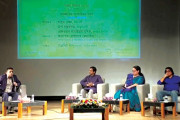Lightning was declared a national disaster in 2016 in Bangladesh. It experiences an average of 80 to 120 days of lightning a year. Bangladesh has the highest number of deaths due to lightning in the world.
।। Majhar Mannan।।
In Chapainawabganj, 16 bridesmaids were killed by lightning and it has hurt the hearts of people across the country. Thunderbolt is a natural phenomenon but at the present time it has turned into a terrible natural disaster especially for Bangladesh. Thunderstorms have increased in recent times and are constantly causing casualties and countless people are being injured and resources are being destroyed. The number of lightning strikes has risen alarmingly over the past few years, with an average of 300 to 400 people dying each year. There have been thunderstorms in the past but no such casualties have been seen in the past.
There have been two main reasons for the increase in the number of lightning strikes and the increase in the number of casualties. Due to global warming, the weather and climate have changed drastically and as a result the type and timing of rainfall has also changed and lightning is increasing. The second reason is that in the countryside there were once a lot of big palm trees, banyan trees and other tall trees but their number has decreased a lot and these trees were used to absorb lightning. Tall trees have been severely reduced and open field lightning is constantly occurring and people are dying.
From March to May every year, there are 40 to 50 lightning strikes per square kilometer in Bangladesh. Although the number of people killed in lightning strikes has been reported in newspapers, the actual number of deaths is much higher. More than 2,000 people have been killed and many more injured by lightning in the last 10 years, according to the Disaster Forum.
Lightning was declared a national disaster in 2016 in Bangladesh. It experiences an average of 80 to 120 days of lightning a year. Bangladesh has the highest number of deaths due to lightning in the world. Experts find some reasons behind the excess lightning in Bangladesh. They are: 1. Climate change and rising temperatures 2. Increase in lead in the air 3. Increase in the use of metals in public life 4.increasing use of mobile phones and its radiation 5. Increasing the number of mobile towers 6. Decrease in the number of tall trees 7. To fill the rivers, canals and wetlands.
There is a close relationship between lightning growth and global climate change.
Bangladesh is one of the most lightning prone regions in the world. There is no alternative to raising awareness among the people and reducing the death rate through the use of technology. Sunamganj, Netrokona, Kishoreganj, Sylhet and Gaibandha districts of the country have high number of lightning strikes and at the same time high death rate. Those who work in the open field and fish in rivers or canals are more likely to be killed by lightning. About 90% of the people who die in Bangladesh due to lightning are men. If one person dies due to lightning, at least 10 people in the vicinity are seriously injured. And almost all the people injured in the lightning strike are in danger of becoming permanently physically disabled. The incidence of lightning in the country has increased by more than 15 per cent in the last few years.
Experts say that the main reason for Bangladesh’s high lightning rate is the country’s geographical location. The Bay of Bengal is located to the south of Bangladesh and the Indian Ocean starts right after the Bay of Bengal and the hilly areas especially the Himalayas are located to the north of Bangladesh. Humid and warm winds come from the Bay of Bengal and the Indian Ocean and from the Himalayas very cold winds come and the combination of hot and cold winds creates a favorable environment for thunderstorms.
After winter, warm air comes from the Bay of Bengal and cold air from the Himalayas, the mixture of both makes a thunderstorm. Among the South Asian countries, Sri Lanka, India and Nepal get lightning but Bangladesh has the highest number of lightning strikes. According to the size of the country, the number of deaths due to lightning in Bangladesh is much higher. And the main reason for the high number of deaths due to lightning is the unawareness of the people.
In developed countries, the death rate due to lightning is much lower. According to meteorologists, thunderstorms are more prevalent in northern and north-western parts of Bangladesh. This is because the temperature in these regions is higher in summer and experts say that if the temperature can reach 1 degree Celsius then the probability of lightning increases 10 times. Although there is some pre-preparedness for disasters like floods and cyclones, the issue of lightning is as sudden as earthquakes. Venezuela and Brazil have the highest number of lightning strikes in the world, but the death toll in Bangladesh is much higher than there.
The Ministry of Disaster Management and Relief has installed lightning detectors in eight places across the country to prevent lightning damage and to give early warning to the people. Lightning at a distance of three miles from the earth produces 1 billion to 10 billion joules of energy and at a rate of 27,840 kilowatts. And if this energy can be stored, a family will be able to use electricity for free for 15 years. Scientists are continuing to try to harness the enormous energy generated by lightning.
A large part of the warm humid air about eight to ten thousand meters above the earth’s surface has occupied the upper atmosphere of Bangladesh but the atmospheric layer below the same part is cold and this retrograde wind helps to create lightning. Many people die every year in Bangladesh due to lightning and 93% of them die in rural areas and about 86% of people die in the open place due to lightning. Many large tools are currently used on agricultural land that are made of metal and can easily attract lightning, so these tools must not be used during the rainy season. The government decided to plant palm trees to save lives from lightning and 2.8 million palm kernels have already been planted. Lightning-proof shelters can also be set up on large open field so that farmers can take shelter there during the rainy season.
As the temperature rises, the thunderstorms will increase, but with a little awareness, it is possible to avoid thunderstorms. However, due to climate change, the temperature in Bangladesh has increased by 0.7 degrees Celsius in the last 40 years. Warm temperatures cause the atmosphere to heat up, and lightning strikes when water vapor comes in contact with it. There are a number of things we must do to avoid lightning.
They are: 1. Stay indoors during lightning and use rubber shoes and avoid open space 2. During thunderstorms we must avoid any tall tree electric poles and mobile towers and stay away from water bodies 3. No mobile computer, TV, laptop or any other device can be used during lightning 4. We must avoid all metals that conduct electricity when lightning strikes 5. No more people can gather in one place during a thunderstorm 6. Lightning protection system must be maintained in every house.
Since no early warning of lightning has yet been discovered, we must be extremely careful and we must plant large trees. There are a limited number of campaigns in the country to protect against lightning, but these campaigns need to be intensified, otherwise the death toll will continue to rise.
The writer is Assistant Professor, B A F Shaheen College, Kurmitola, Dhaka Cantonment.










































































































































































